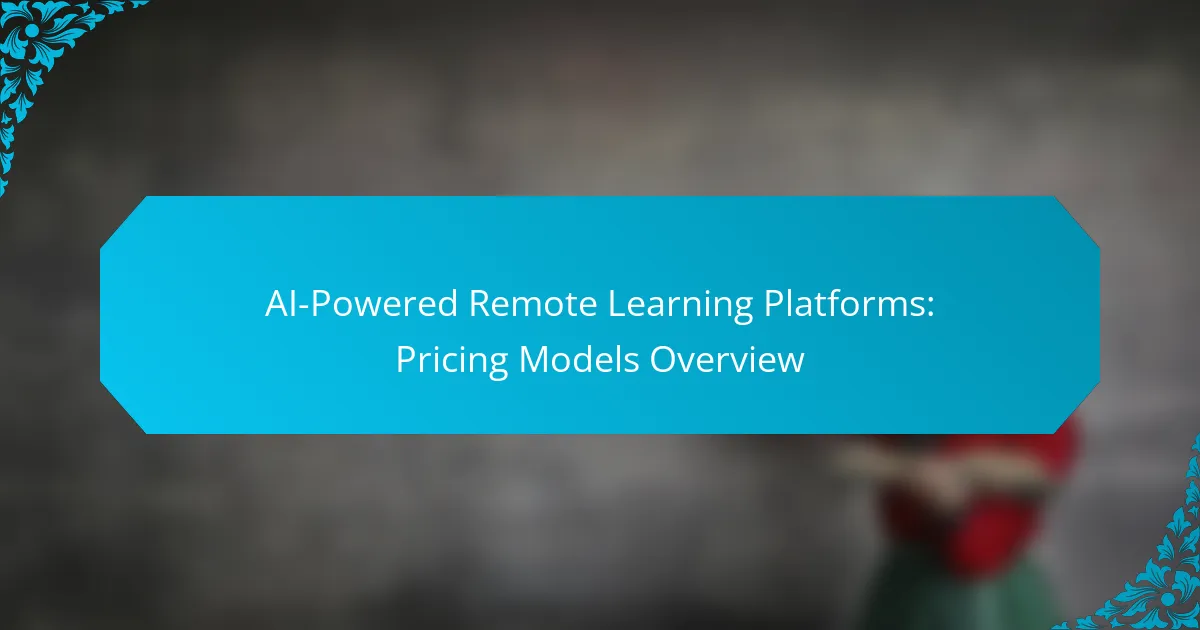AI-powered remote learning platforms utilize advanced technology to deliver personalized and adaptive educational experiences, making learning more engaging and effective. With a variety of pricing models available, users can find options that best fit their budget and learning requirements, ranging from affordable subscriptions to premium courses. Understanding these pricing structures is essential for selecting the most suitable platform for individual educational goals.

What Are the Best AI-Powered Remote Learning Platforms?
The best AI-powered remote learning platforms leverage artificial intelligence to enhance the learning experience, offering personalized content, adaptive assessments, and interactive features. These platforms cater to various learning needs and preferences, making education more accessible and efficient.
Coursera
Coursera partners with universities and organizations to provide a wide range of courses, specializations, and degrees. The platform uses AI to recommend courses based on user interests and past learning behavior, enhancing the personalization of the learning journey.
Pricing varies, with many courses available for free, while specializations and degrees can range from a few hundred to several thousand dollars. Users can often access financial aid options to help cover costs.
Udacity
Udacity focuses on tech-related fields, offering “Nanodegree” programs designed in collaboration with industry leaders. The platform employs AI to tailor learning paths and provide real-time feedback on projects, ensuring learners stay on track.
Prices for Nanodegree programs typically range from $399 to $1,200, depending on the course length and complexity. Udacity often provides discounts and scholarships, making it more accessible for learners.
edX
edX offers a diverse selection of courses from top universities and institutions, utilizing AI to enhance course recommendations and assessments. The platform supports both individual courses and MicroMasters programs, allowing learners to earn credentials recognized by employers.
Many courses are available for free, with verified certificates costing between $50 and $300. edX also provides financial assistance for eligible learners, making it a cost-effective option for many.
Skillshare
Skillshare focuses on creative and practical skills, offering a community-driven learning experience. The platform uses AI to suggest classes based on user preferences and engagement, fostering a personalized learning environment.
Membership costs around $19 per month or $99 annually, providing unlimited access to all courses. Skillshare often runs promotions, making it easier for new users to try out the platform.
LinkedIn Learning
LinkedIn Learning offers a vast library of professional courses, integrating AI to recommend content based on career goals and skills. This platform is particularly beneficial for professionals looking to upskill or pivot in their careers.
Subscriptions are priced at approximately $29.99 per month or $239.88 annually, with a free trial available for new users. LinkedIn Learning also provides insights into trending skills and courses relevant to specific industries.

How Do Pricing Models Differ Among Platforms?
Pricing models for AI-powered remote learning platforms vary significantly, impacting how users access and pay for educational content. Understanding these differences helps users choose the most cost-effective option for their learning needs.
Subscription-based pricing
Subscription-based pricing allows users to pay a recurring fee, typically monthly or annually, for access to a library of courses and resources. This model often provides unlimited access to content, making it ideal for learners who wish to explore multiple subjects over time.
Prices for subscriptions can range from around $10 to $50 per month, depending on the platform and the breadth of content offered. Users should consider their learning goals and frequency of use when selecting a subscription plan to ensure they get the best value.
Pay-per-course pricing
Pay-per-course pricing requires users to pay a one-time fee for each individual course they wish to take. This model is beneficial for learners who want to focus on specific skills or topics without committing to a long-term subscription.
Course prices can vary widely, typically ranging from $20 to several hundred dollars, depending on the course’s depth and the platform’s reputation. It’s advisable to check for discounts or bundled offers that can reduce costs for multiple courses.
Freemium models
Freemium models offer basic access to courses and materials for free, with the option to upgrade to a paid version for additional features or content. This approach allows users to try out the platform before committing financially.
While freemium models can be appealing, users should be aware that free access may come with limitations, such as fewer courses or lack of personalized support. Evaluating the benefits of upgrading against personal learning needs is crucial to making an informed decision.

What Are the Cost Ranges for AI-Powered Learning Platforms?
The cost of AI-powered learning platforms varies significantly based on features, course offerings, and subscription models. Generally, users can expect to pay anywhere from a few hundred to several thousand dollars per course or subscription, depending on the platform and the depth of content provided.
Coursera pricing overview
Coursera offers a range of pricing options, including free courses, monthly subscriptions, and one-time payments for individual courses. Subscription plans typically range from around $39 to $79 per month, allowing access to multiple courses and specializations.
For professional certificates and degree programs, costs can escalate to several thousand dollars. Users should consider the value of the certification or degree in their career path when evaluating these options.
Udacity pricing overview
Udacity primarily focuses on “Nanodegree” programs, which are priced between $399 and $1,200, depending on the subject and duration. Users can choose between monthly payments or a one-time fee for the entire program.
Udacity often provides discounts and scholarships, making it essential for prospective learners to check for available offers. The investment can be worthwhile for those looking to gain skills in high-demand fields like data science or artificial intelligence.
edX pricing overview
edX features a variety of pricing structures, including free access to course materials with an optional verified certificate for around $50 to $300. MicroMasters programs and professional certificates can range from $300 to $1,500, depending on the complexity and duration.
When selecting courses on edX, learners should assess their goals and the potential return on investment, especially if pursuing a verified certificate that can enhance their resume.

What Factors Influence Pricing Models?
Several key factors influence the pricing models of AI-powered remote learning platforms, including the quality of course content, the expertise of instructors, and the features offered by the platform. Understanding these elements can help users choose the right platform that fits their budget and learning needs.
Course content quality
The quality of course content significantly impacts pricing. High-quality materials, including interactive elements and up-to-date information, often lead to higher costs. Platforms that invest in professional-grade content may charge more, but they typically provide better learning outcomes.
When evaluating course content, consider factors such as the depth of information, engagement level, and the inclusion of multimedia resources. Platforms offering courses with comprehensive materials may range from $50 to $500 per course, depending on the subject and complexity.
Instructor expertise
Instructor expertise is another critical factor affecting pricing. Courses led by industry experts or recognized educators tend to be priced higher due to their credibility and the value they bring. Users should assess the qualifications and experience of instructors before enrolling.
For instance, courses taught by renowned professionals may cost between $200 and $1,000, while those led by less experienced instructors might be available for $50 to $200. Investing in courses with experienced instructors can enhance the learning experience significantly.
Platform features
The features offered by a remote learning platform can vary widely and influence pricing models. Platforms with advanced features such as AI-driven personalized learning paths, interactive forums, and robust analytics tools generally charge more. Users should consider which features are essential for their learning experience.
Basic platforms may start at around $10 per month, while those with comprehensive features can exceed $100 monthly. It’s essential to evaluate the cost against the benefits of features like progress tracking and community support to ensure value for money.

How to Choose the Right Platform for Your Needs?
Choosing the right AI-powered remote learning platform involves assessing your specific educational goals and budget constraints. A clear understanding of what you want to achieve and how much you can spend will guide you in selecting the most suitable option.
Assessing learning goals
Start by defining your learning objectives. Are you looking to enhance skills in a specific area, or do you need a comprehensive curriculum? Identifying whether you need personalized learning paths or standardized courses can significantly influence your choice.
Consider the target audience as well. For instance, platforms tailored for K-12 students may differ from those designed for adult learners or corporate training. Aligning the platform’s offerings with your learning goals ensures a better fit.
Evaluating budget constraints
Budget is a critical factor when selecting a remote learning platform. Prices can vary widely, with some platforms offering subscription models ranging from $20 to $100 per month, while others may charge per course or user. Determine what you can realistically allocate for this investment.
Additionally, consider hidden costs such as licensing fees, additional resources, or support services. It’s wise to compare several platforms to understand the overall value they provide relative to their pricing structure.
